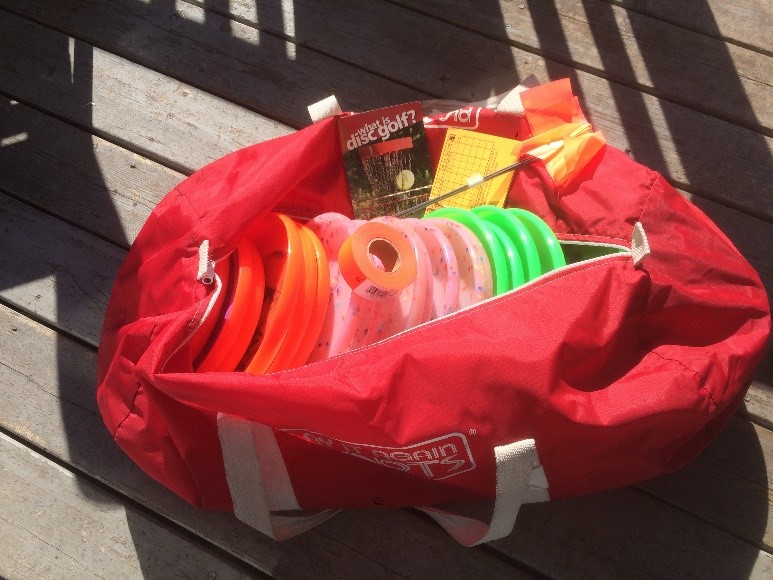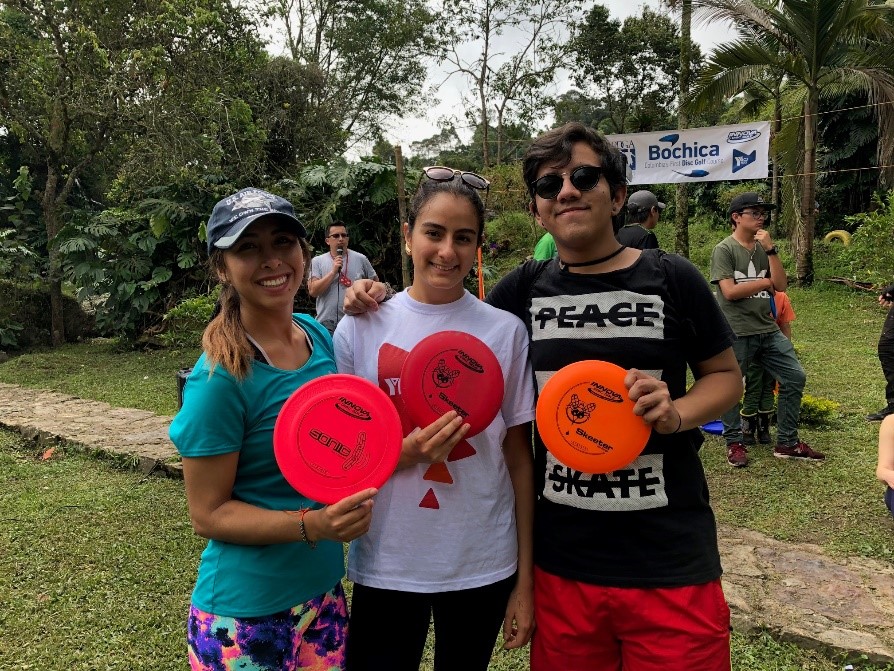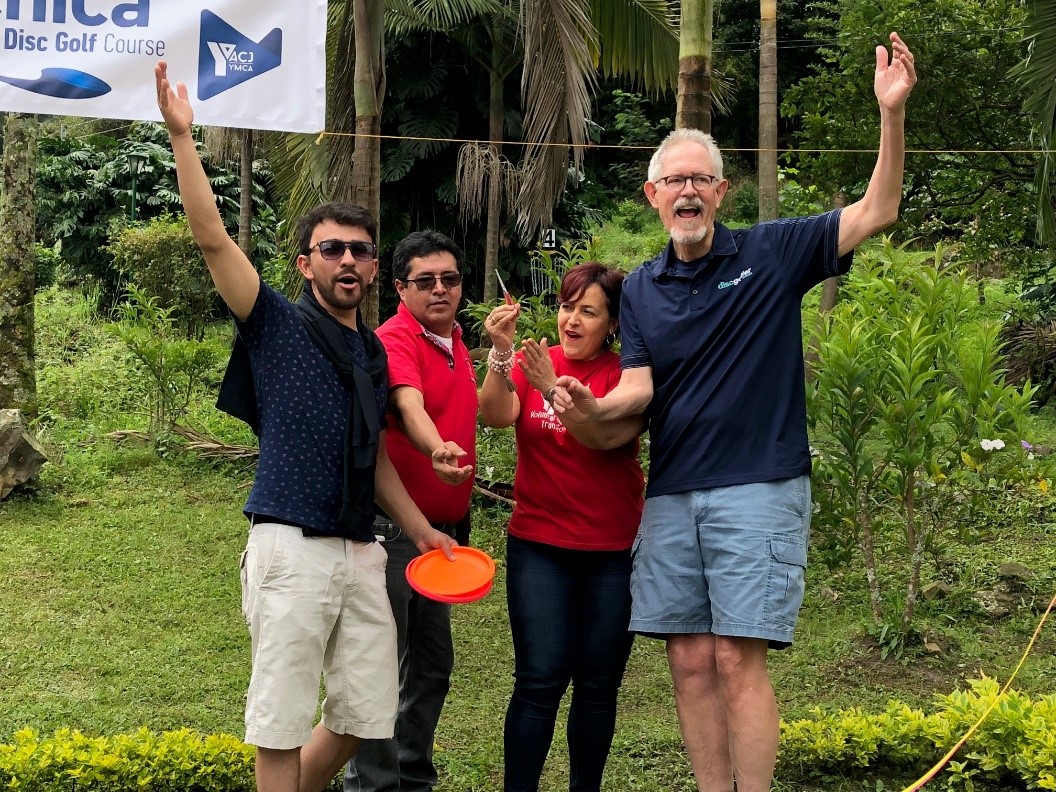Campamento Bochica: Colombia’s First Disc Golf Course
Campamento Bochica: Colombia’s First Disc Golf Course

Nicolas, age 9, lines up a shot at the new disc golf course at Campamento Bochica in Bogotá, Colombia. Photo: Joe Feidt
Chévere (cool) is a very nice compliment from a Colombian, and that’s what many of them called their first disc golf experience in their home country. It was at Campamento Bochica, the scenic YMCA camp located south of Bogotá that is now home to Colombia’s first disc golf course. This historic Marco Polo project to get disc golf off the first tee in the South American nation succeeded far better than expected and cost significantly less than projected. It was a one-week, whirlwind disc golf project that had its roots in an earlier trip.
Seeds Planted In March 2018
The first seeds were planted in March 2018, when I was fortunate enough to travel to Bogotá with a group of eight YMCA volunteers and members from Minnesota and Wisconsin. Most of our itinerary involved visiting social service agencies operated by the Bogotá YMCA. Unlike YMCAs in the United States, the Bogotá Y offers neither treadmills nor swimming pools; rather, it runs two schools and offers a bunch of outreach programs to people in Bogotá who can use a helping hand: career training and job placement help for single mothers and their children, and for prostitutes and their kids, and after-school programs for young kids through teens (and many other programs). Our group saw some of what they are doing. It is very organized and very impressive.
One of the days we were scheduled to visit YMCA Camp Bochica. That got my attention. When I heard we were going there and learned a bit about the camp, I got the idea of bringing a “disc golf object course in a bag.” I thought there might be enough time and acreage to set up a course. I called Discovering the World, a business that’s been selling Frisbees and golf discs for decades. The owner, Dan Mangone, was all-in when he heard what I was planning. They sent me 30 Fastbacks and double disc court discs at no cost at all; they even paid the freight. I threw the discs into a big red duffel bag and added tee marker flags, a roll of fluorescent tape to wrap the trees/objects, some PDGA ¿Qué es Disc Golf? brochures, a couple of DiscGolfer magazines, a few sharpies and golf pencils, and some generic scorecards. I checked it through at the Minneapolis airport and headed south.

A disc golf object course in a bag. Photo: Joe Feidt
We arrived late at night at Camp Bochica. The camp is more like a rustic resort circa 1970, with its motel-like rooms with indoor plumbing and electricity. Early the next morning I set up the course and gave a demo to about 20 teens. Before we left that morning, I met with the camp’s director, Hamel Oviedo, walked the course with him, and told him I was leaving him with a bagful of Frisbees, brochures, mags, etc., and gave him my contact information. Hamel was receptive to my idea and said disc golf would make a good addition to their recreational activities. By 11:00 that morning, our group was off to Bogotá.
One Disc Golf Course Fits in Two Bags
On the flight home, it occurred to me the camp was an ideal place to introduce disc golf to Colombia and could be a stepping stone to other South American countries. I felt my effort at an object course, while well-intended, was insufficient, and that a basket course was called for. When I got home, I contacted Mónica Agudelo at the YMCA there and asked her if she thought a more permanent basket-style course would be a good idea. She liked the idea but wanted to talk to Hamel. He fully supported the idea. She got back to me with an emphatic sí and asked for my help to launch it. I was able to contact Sam Ferrans at Innova, and he was very supportive and said they would donate whatever we needed. That was the green light I needed, so I applied for a PDGA Marco Polo grant. Before long, my application was approved.
We ran into a problem getting a quote for shipping. A week passed and still no quote. It became clear that none of Innova’s shippers wanted to ship to Colombia because of customs, duty fees, and taxes. It was then I came up with a novel idea: What if I personally could transport some baskets and discs with me as checked-through baggage? From my earlier trip I knew Delta allowed two 50-pound bags free on flights to South America. Sam told me their Traveler portables weighed 20 pounds each. Hmm.
I added up the poundage and realized I could take four Travelers and still have 10 pounds remaining in each bag, enough for 50 light, easy-to-throw EDGE discs (Sharks, Skeeters, Birdies and Sonics), many minis, and swag. So, for this Marco Polo trip it would be four portables and 50 golf discs in two huge bags. I also threw in six Discraft UltraStars for ultimate, more tee flags, a box of golf pencils, a very cool 2x6-foot vinyl banner with grommets, more brochures, another DiscGolfer magazine, and a roll of duct tape. Would this be enough to make an impact? I guessed it would be and — surprise! — I was right.
Mónica asked if I could be there the first weekend in June (a long three-day weekend with a national holiday on Monday) to show a group of 70 YMCA volunteers how to play. Still waiting for a freight quote and because of the general uncertain nature of shipping to South America, I decided to go ahead and make an airline reservation to cover that weekend and take the equipment with me as checked-through baggage. I ordered two 50X30 heavy duty canvas bags to tote the equipment.
The two canvas bags and the five huge boxes of Innova equipment arrived the same day. My first thought was, "How in the name of “Steady” Ed am I going to fit this stuff into two bags?" I unboxed the Travelers, and two of them fit nicely into each bag. That was a relief. I divided the discs between the two satchels and there were space and weight to spare. Each bag weighed about 48 pounds, and I had one carry-on roller with my personal stuff. At the airport, I got a nasty look from the Delta baggage attendant, but he slapped on the BOG baggage tags. Before landing, I declared everything on my customs form. When I arrived at customs, two somewhat perplexed officials advised me to ship by conventional courier next time, but said they would let it slide. That was another huge relief. At midnight Jaime, a driver from the YMCA, picked me up and dropped me off at my hotel.
The next day I had a late breakfast with YMCA director Gloria Hidalgo, Mónica Agudelo, the Y’s volunteer coordinator named Aguines, and several other staff members at the YMCA office in Bogotá. They welcomed me with open arms and told me how much they appreciated my efforts. Jaime drove me to the camp after breakfast. Leaving the traffic-clogged streets of Bogotá, we dropped about 1,000 feet and followed the serpentine Rio Bogotá down through a steep gorge in the Andes. Arriving at the camp gates, I met Hamel and got settled in my room. We soon met at the recreation center and talked course design and walked through the area where the course would track. I was surprised and pleased to learn that, when he heard I was returning, he had begun looking at plans for building steel baskets and had even picked out a local metal worker, Mauricio, to construct them. This hombre had also been checking out PDGA.com and was totally into disc golf! I realized then I was not going to have to convince him how cool the sport was. Instead of laying out a longer course using objects to augment the portables, we decided to make a short, fun, four-hole course using the Innova Travelers. Because we were limited by time for the demo and tournament, a shorter course made sense.

YMCA Youth showing off their new discs at Camp Bochica. Photo: Joe Feidt
70 YMCA Youth Volunteers Arrive
The YMCA youth volunteers arrived in two busloads the next evening. These are the best of the best of Colombian youth; they ranged in age from nine years to some in their mid-20s. They were there to get to know each other, be trained to learn more about the Y Way, and to take on more responsibility and learn leadership skills. The group was divided into sub-groups with leaders chosen — classic Y procedure. I quickly discerned these were amazing kids: smart, fun-loving, outgoing, and rambunctious. Most were Colombian, along with a group of six Germans who were living and working in Bogotá during their gap year before college. Everyone was working on their English skills.
YMCA camps, by their nature, are well-organized and activities are slotted into a busy schedule. I would have from 9:00 a.m. until noon on Saturday to present some background on disc golf, demonstrate how to throw, and to play a demo round using volunteers. A few had heard of disc golf. We went over the basic rules, the Disc Golfer’s Code, and courtesy. Although many of the kids spoke English, I presented in Spanish. Everything went well, and it was obvious they really liked this new (to them) game.
But enough hablar (talk): it was time to jugar (play). After the session, some very eager volunteers and I played the course while the others watched. It was obvious the jovenes (youths) liked the game and caught on quickly how to play.
In the afternoon, Hamel and I went over preparations for Sunday: I would read a welcome letter from PDGA International Director Brian Hoeniger, followed by the ribbon-cutting ceremony, then the throwing out of the first disc, and, finally, the much-anticipated competition. Because the Y Way is very team-oriented, we decided on coed teams of four. Eleven teams signed up (44 players), which was over half the group. We also had a team from the nearby town, Santandercito. We only had two hours for the ceremony and tournament, so we planned things to run smoothly. I felt people would want to see their new friends teeing off on the first hole, so they all teed off from hole 1 in front of the banner proclaiming Colombia’s first course. I served as roving answer man/photographer.

Ribbon-cutting at Colombia's first course. Left to right: William, the emcee, camp director Hamel Olviedo, YMCA Bogotá's Mónica Agudelo, and Joe Feidt. Photo: Valentina Moreno
Due to the tight time limitations, we decided to run a prelim followed by the top three teams competing in a start-from-scratch finals. We were running a half hour late, so we decided to have all 12 players have a CTP contest to decide which team would win. All but two of the players were in their teens or early 20s; one player, Nicolas, was just nine years old and could not have weighed more than 100 pounds. You guessed it: The kid based his drive to win it for his team! He was so overcome with emotion, he cried his eyes out for about five minutes. I gave him a hug, signed an Innova mini for him, and told him I thought he’d one day be the Colombian National Champion. Nicolas has not only a knack for the game, he has a passion for it. The next day, when we got off the bus taking us to Bogotá from the camp, I met his proud parents. They already knew what had happened and wanted to know all about disc golf.
Muchísimas Gracias
First of all, Marco Polo Colombia cost significantly less than anticipated: $2,364 was budgeted versus $1,860 of actual expenses. This was due to Delta shipping everything free of charge, which is pretty amazing (Thank you, Delta!), and Old Joe serving as the mule. So, our total freight cost was just five UPS boxes shipped from California to my home in Hudson, Wisconsin. Another big savings was that YMCA Bogotá paid for almost all of my in-country expenses: my five-day stay at the camp, including meals and a visit to a local restaurant, as well as all of my transportation in Colombia.
This project unfolded far better than I imagined. I had several worrisome questions going in: Would Delta even allow me to ship these two huge bags? Would Colombian customs seize everything or impose duties and taxes? Would the YMCA camp director be as enthusiastic as I was? How would kids who had never heard of disc golf react? I was a bit apprehensive.
Delta could have said, “Forget it!” Colombian customs could have made a big stink, but chose not to. The camp director, Hamel, could have been lukewarm to the new sport; instead, he has a passion for it and is planning on having permanent steel baskets made, enlarging the course to at least nine holes (we discussed basic design tenets and walked through a prospective course), and incorporating the sport into his other activities for the hundreds of young people who will be coming through the camp every year. We have already made plans to restock the discs. Two Colombian YMCA volunteers are currently at YMCA Camp St. Croix here in my hometown working as counselors, and the plan is for them to bring back discs when they return home in August. (Minnesota and Wisconsin disc golfers: we need your lightly-used, easy-to-throw discs!)
And the young people. They were so enthusiastic, it touched my heart and amazed me. These kids were playing this little four-hole course before breakfast, after breakfast – actually any free time they had. They were playing catch with the Fastbacks and DDC discs. They were playing pickup ultimate games on a concrete basketball court with the UltaStars at night under lights. They were loving playing with discs! They showed their appreciation for my coming down there by making a very nice photo album to take home and also making two beautiful wooden plaques of appreciation (one for me, and one that will stay at the camp). Many kids thanked me personally for doing what I did. Some gave me hugs. It was very touching to experience such appreciation; it made my time and efforts totally worth it.
I have no doubt at all disc golf will work well at YMCA Camp Bochica; it will expose hundreds of people every year to the sport, and hopefully some of these people will decide to start clubs and design courses and build baskets and buy discs. I told Hamel I was only planting a few disc golf seeds on this trip, and he understands he is the jardinero (gardener) who will need to cultivate the sport at the camp so that others are can embrace it.
Will disc golf work in other YMCA camps in South America? This is my longer-term vision. I will check back with Mónica and Hamel at the end of the summer to see how the first three months went and will file a follow-up report. Assuming it is going well, I will consider planting more seeds at another YMCA camp in South America.
Finally, on behalf of all the youngsters who got (and will get) an opportunity to play disc golf in Colombia and from the appreciative staff of YMCA Bogotá and camp director Hamel Olviedo, muchísimas gracias to the PDGA staff and board for supporting this successful Marco Polo project. As they say in Colombia: ¡Disc golf es chévere!

Comments
Thank you for all your
Thank you for all your efforts as an ambassador to the sport! That was a fantastic story - very inspiring. Is it possible, or is there a place we can send lightly used discs to contribute to the sport down in Columbia?
Gracias, Robbio, What a great
Gracias, Robbio, What a great idea! You could send lightly-used golf discs (and Frisbees) to the main YMCA office in Bogota. The address is:
ACJ Bogotá (ACJ means YMCA in Spanish)
Carrera 16a #28b-33
Teusaquillo
Bogotá, 111311
Colombia
Also, I'm collecting lightly
Also, I'm collecting lightly-used, easy-to-throw discs right now to give to some Colombians to take down there. There are 4 YMCA counselors from Colombia working this summer at Camp St. Croix in Hudson, WI. I'm going to give them a bag o' discs to tote down there when they return in late July. If you have some discs and live anywhere near Hudson (or the Twin Cities), let me know so we can meet up.
This must be Colombia's 2nd
This must be Colombia's 2nd course since Guaskington has been in since 2012, here is the link: <https://www.pdga.com/course-directory/course/guaskington>. Also, it would be great if you could add it to the course directory.